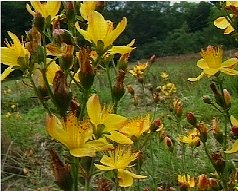The Woodland Education Centre
Heathland Project Introduction Contents Summary
Other Heath Species on the Project Site
 left: St John's wort is present on the Heathland Restoration site.
left: St John's wort is present on the Heathland Restoration site.
Many other plants characteristic of heathland communities are now present on the project site. (These species are marked with an asterisk * in the species list.)
Bristle Bent (Agrostis curtisii) is gradually spreading, as are sedges such as Green-ribbed Sedge (Carex binervis) and Pill Sedge (Carex pilulifera), which are characteristic of heathlands (Chart). Tormentil (Potentilla erecta) is also very slowly increasing in abundance (Chart). Other heath species occurring on the site include Heath Woodrush (Luzula multiflora) and Heath Speedwell (Veronica officinalis). Overall, the indications are that the vegetation on the project site is gradually shifting towards becoming a dry heath community.
Heath species require acid soils, low in nutrients. The soils are acidic on the project site, with a pH ranging from 4.0 - 5.0. Many of the plants found over substantial areas of the project site are species which have a strong preference for acid soils. These include all the heath species mentioned above, plus species such as Foxglove (Digitalis purpurea), Rowan (Sorbus aucuparia), Eared Willow (Salix aurita) and Polytrichum formosum. Many of the plants are species which also specifically avoid lime. For example, Slender St. John’s Wort (Hypericum pulchrum), which occurred over virtually the whole area, is an indicator of soils deficient in calcium salts. The soils may be more fertile than is normal for heathland, as indicated by the presence of species such as the moss, Brachythecium rutabulum. It is likely that over time, continued leaching of the soils by rainfall, and the cutting and removal of vegetation, will further lower the pH and reduce the nutrient status of the soil to more optimum conditions for heathland plants.
Continue to mosses on the Heathland
Restoration site![]()
| Heathland Restoration Project Report | ||||
Other Lowland Heaths in East Devon
